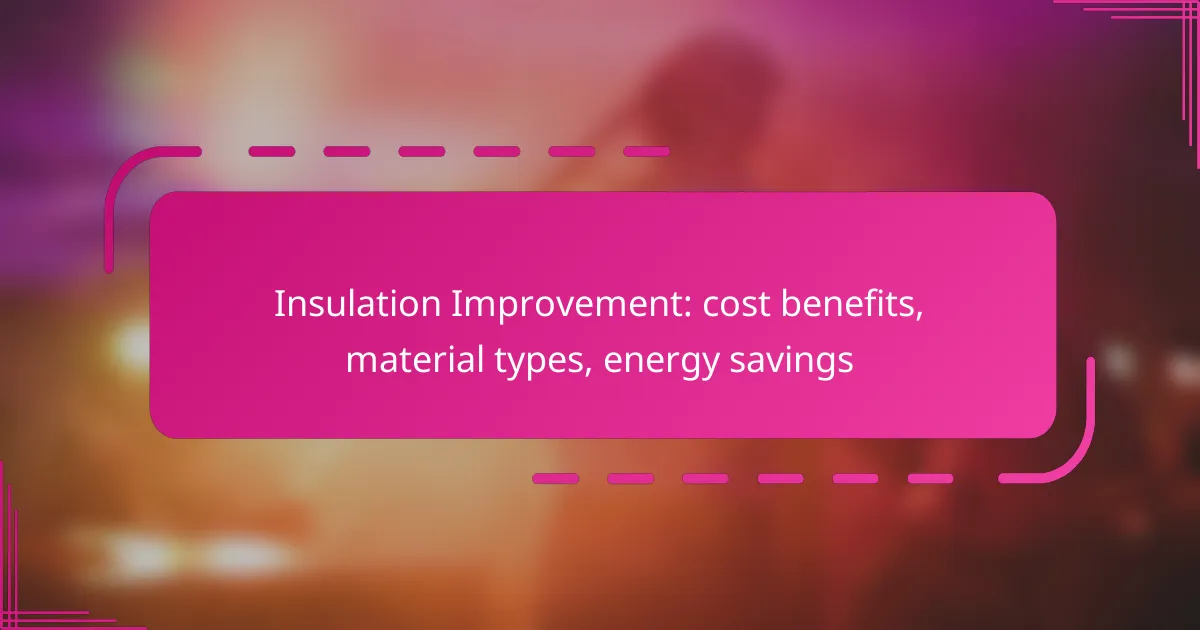Improving insulation in homes is a cost-effective strategy that significantly reduces energy expenses by minimizing heat loss during winter and heat gain in summer. With a variety of insulation materials available, homeowners can select options that best suit their budget and energy efficiency needs, ultimately leading to enhanced comfort and lower utility bills.
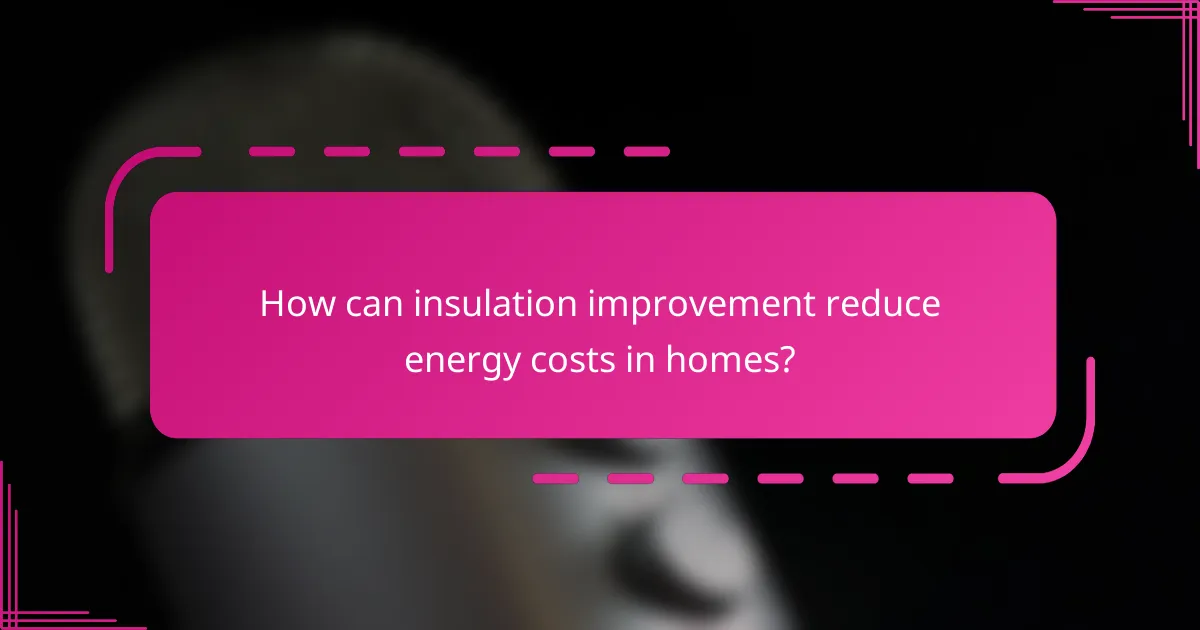
How can insulation improvement reduce energy costs in homes?
Improving insulation in homes significantly lowers energy costs by minimizing heat loss in winter and heat gain in summer. Effective insulation keeps indoor temperatures stable, reducing the need for heating and cooling systems to work harder.
Lower heating and cooling expenses
Enhanced insulation directly translates to lower heating and cooling expenses. By properly insulating walls, attics, and floors, homeowners can reduce energy consumption by as much as 20-30%. This means less reliance on HVAC systems, leading to lower monthly utility bills.
For example, upgrading to high-quality insulation materials like spray foam or fiberglass batts can create a more energy-efficient home. Homeowners may notice a significant reduction in their energy bills within the first few months after installation.
Increased home value
Improving insulation can increase a home’s market value. Energy-efficient homes are increasingly attractive to buyers, as they promise lower utility costs and a more comfortable living environment. Homes with upgraded insulation often sell for higher prices compared to similar homes without such improvements.
Investing in insulation can yield a return on investment of 70-100% when selling the property. This makes it a financially sound decision for homeowners looking to enhance their property value.
Tax incentives for energy-efficient upgrades
Many governments offer tax incentives for homeowners who make energy-efficient upgrades, including insulation improvements. These incentives can take the form of tax credits or rebates, which can significantly offset the initial costs of insulation projects.
For instance, in the United States, homeowners may qualify for federal tax credits that cover a percentage of the costs associated with energy-efficient home improvements. It’s advisable to check local regulations and available programs to maximize savings on insulation upgrades.
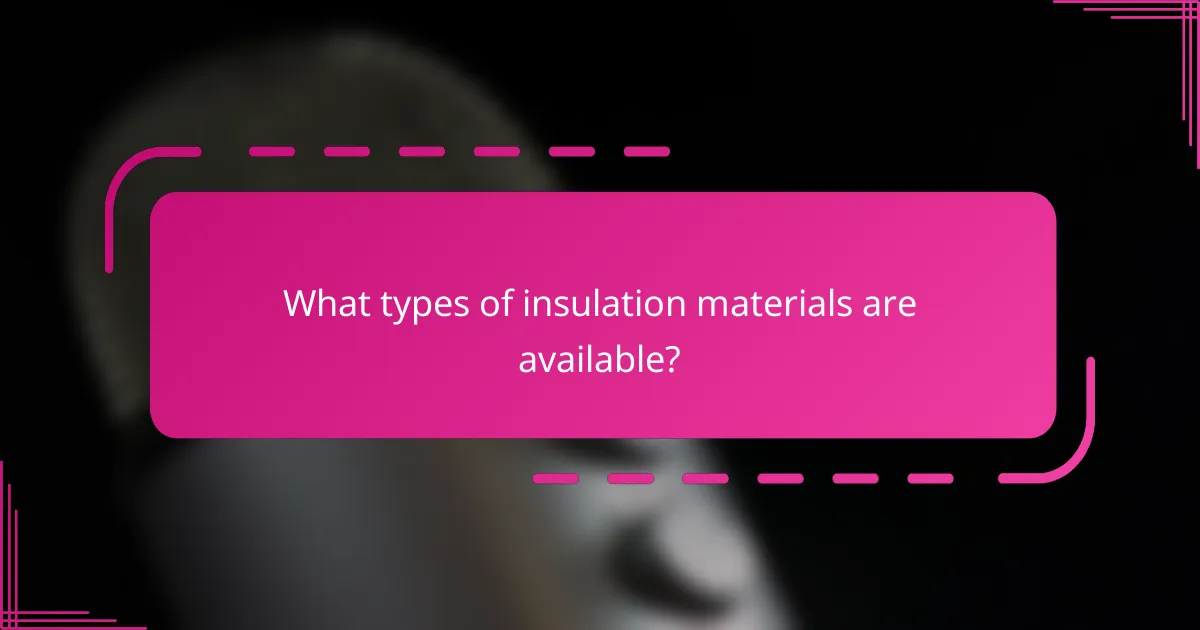
What types of insulation materials are available?
Various insulation materials are available, each with unique properties and benefits. Choosing the right type depends on factors such as cost, energy efficiency, and specific application needs.
Fiberglass insulation
Fiberglass insulation is one of the most common types used in residential and commercial buildings. It consists of tiny glass fibers that trap air, providing effective thermal resistance.
Typically available in batts, rolls, or loose-fill forms, fiberglass insulation is relatively affordable, with costs often ranging from $0.50 to $1.50 per square foot. It is important to ensure proper installation to avoid gaps that can reduce its effectiveness.
Foam board insulation
Foam board insulation is a rigid panel made from polystyrene or polyisocyanurate, offering high insulating values in thinner profiles. This type is particularly useful for insulating foundation walls and exterior sheathing.
Costs for foam board insulation can vary, generally falling between $1.00 and $3.00 per square foot. Its moisture resistance makes it suitable for areas prone to dampness, but care must be taken during installation to seal edges properly to prevent air leaks.
Cellulose insulation
Cellulose insulation is made from recycled paper products treated with fire retardants, making it an eco-friendly option. It is typically installed as loose-fill material, which can be blown into attics and walls.
This type of insulation is effective at reducing air leaks and can be cost-effective, usually ranging from $0.75 to $2.00 per square foot. However, it is essential to ensure that it is installed by professionals to achieve optimal density and performance.
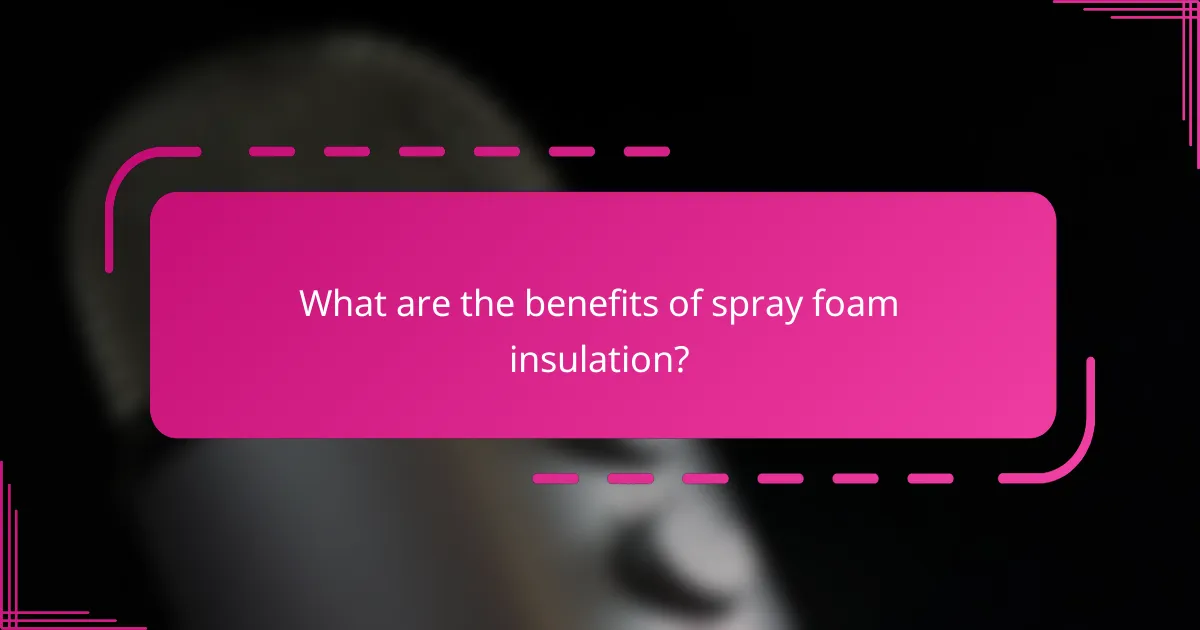
What are the benefits of spray foam insulation?
Spray foam insulation offers significant advantages, including superior energy efficiency and enhanced comfort in homes. Its unique properties help reduce energy costs and improve indoor air quality.
Superior air sealing
Spray foam insulation provides an exceptional air seal, minimizing air leaks that can lead to energy loss. This tight seal prevents drafts and helps maintain a consistent indoor temperature, which is crucial for comfort and energy savings.
When installed correctly, spray foam expands to fill gaps and cracks, ensuring that even the smallest openings are sealed. This characteristic makes it an ideal choice for attics, basements, and other areas prone to air infiltration.
High R-value per inch
One of the standout features of spray foam insulation is its high R-value per inch, which typically ranges from 6 to 7. This means it provides excellent thermal resistance with less material compared to traditional insulation types.
Due to its superior R-value, homeowners can achieve better insulation performance in tighter spaces, making it a practical choice for renovations or new constructions where maximizing energy efficiency is a priority.
Moisture resistance
Spray foam insulation is inherently moisture-resistant, which helps prevent mold growth and structural damage caused by water infiltration. Its closed-cell variant is particularly effective in areas with high humidity or potential water exposure.
By acting as a barrier against moisture, spray foam insulation not only protects the building envelope but also contributes to healthier indoor air quality. This is especially beneficial in climates where humidity levels are a concern.
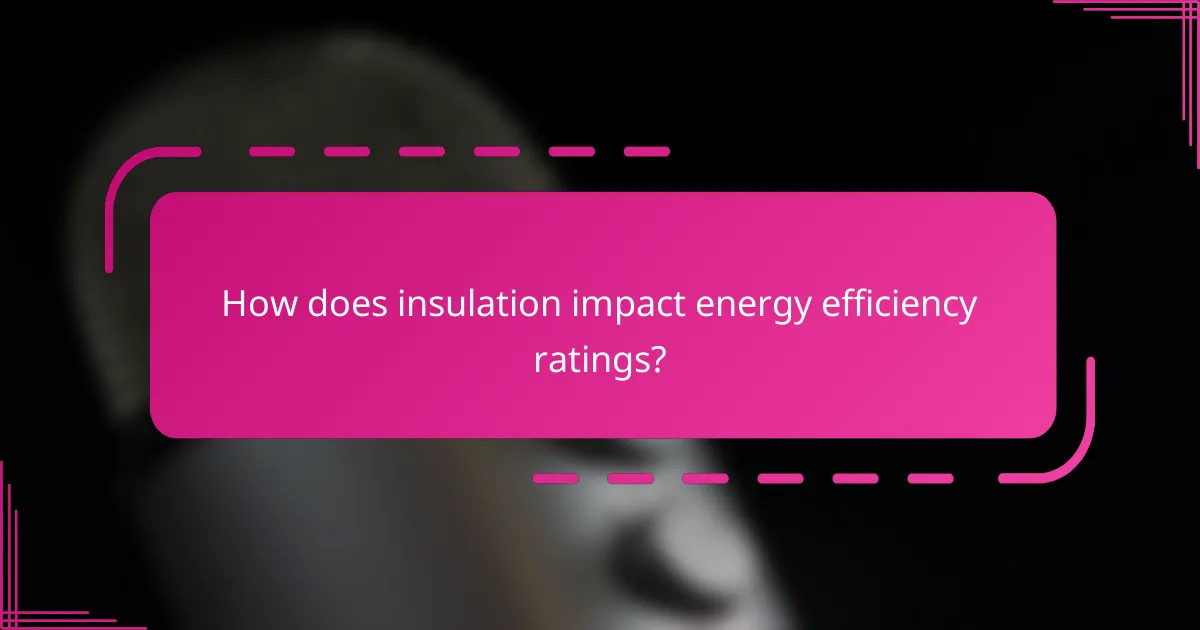
How does insulation impact energy efficiency ratings?
Insulation significantly enhances energy efficiency ratings by reducing heat transfer, which leads to lower energy consumption for heating and cooling. Better insulation results in improved ratings on energy efficiency scales, reflecting a building’s overall performance and sustainability.
Improves Energy Star ratings
Insulation plays a crucial role in achieving higher Energy Star ratings, which indicate a building’s energy efficiency compared to similar structures. By minimizing heat loss in winter and heat gain in summer, well-insulated homes can qualify for Energy Star certification, leading to potential savings on energy bills.
To improve your Energy Star rating, consider using insulation materials with high R-values, which measure thermal resistance. Common insulation types include fiberglass, foam board, and spray foam, each offering varying levels of effectiveness and cost.
Enhances HERS index scores
The Home Energy Rating System (HERS) index scores homes based on their energy efficiency, with lower scores indicating better performance. Effective insulation can significantly lower HERS scores by reducing the energy required for heating and cooling, making homes more appealing to buyers.
To enhance your HERS index score, focus on sealing air leaks and using high-quality insulation materials. A well-insulated home not only improves comfort but can also lead to increased property value and lower utility costs over time.
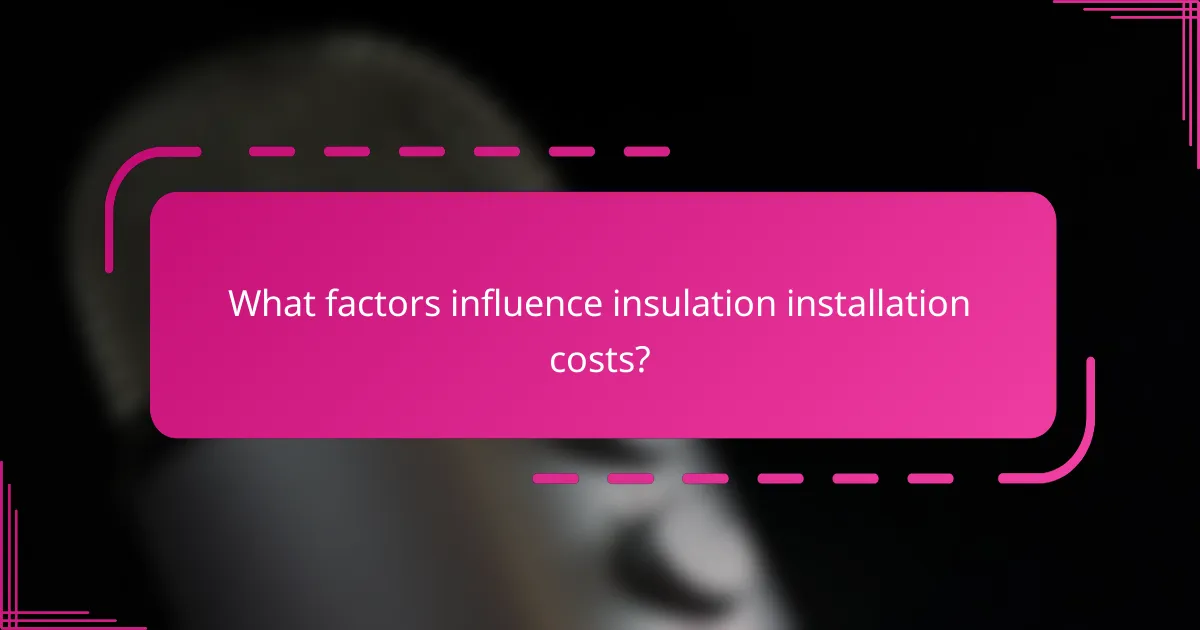
What factors influence insulation installation costs?
Insulation installation costs are primarily influenced by material type, home size, and local labor rates. Understanding these factors can help homeowners budget effectively and make informed decisions about their insulation projects.
Material type and quality
The type and quality of insulation material significantly affect installation costs. Common materials include fiberglass, foam board, spray foam, and cellulose, each with varying price points and performance characteristics. For instance, spray foam tends to be more expensive but offers superior air sealing and energy efficiency.
When selecting insulation, consider the R-value, which measures thermal resistance. Higher R-values typically indicate better insulation performance but may come at a higher cost. It’s essential to balance upfront costs with long-term energy savings.
Home size and layout
The size and layout of a home directly impact insulation installation costs. Larger homes require more materials and labor, leading to higher overall expenses. Additionally, complex layouts with many corners or levels may increase labor time and costs due to the need for more precise installation.
Homeowners can estimate costs by calculating the square footage of areas needing insulation. For example, insulating an average-sized home (around 1,500 to 2,500 square feet) may range from a few thousand to several thousand dollars, depending on the chosen materials.
Labor costs in urban areas
Labor costs for insulation installation can vary significantly based on location, particularly in urban areas where demand is higher. In cities, skilled labor may command premium rates, which can increase the total project cost. Homeowners in urban settings should expect to pay more compared to rural areas.
To manage labor costs, consider obtaining multiple quotes from local contractors. This approach allows homeowners to compare prices and services, ensuring they receive a fair rate for quality work. Additionally, scheduling installations during off-peak seasons may lead to cost savings.
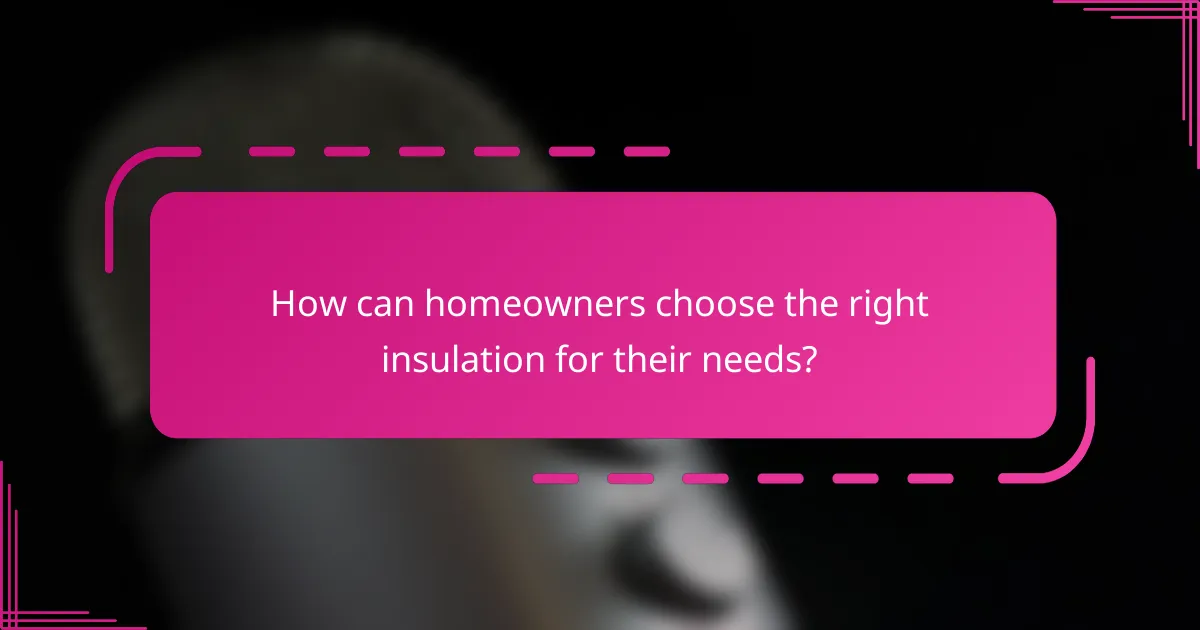
How can homeowners choose the right insulation for their needs?
Homeowners can choose the right insulation by considering factors such as climate, budget, and the specific areas of their home that need insulation. Evaluating material types and their respective energy savings will also guide the decision-making process.
Cost benefits of insulation improvements
Investing in insulation improvements can lead to significant cost savings on energy bills. Proper insulation reduces heating and cooling costs by minimizing energy loss, often leading to savings of 10-20% on monthly utility expenses.
Initial costs vary by material and installation method, but many homeowners find that the long-term savings outweigh the upfront investment. For example, spray foam insulation may have a higher initial cost but can provide better energy efficiency compared to traditional fiberglass insulation.
Material types for insulation
Common insulation materials include fiberglass, foam board, spray foam, and cellulose. Each type has its own advantages; for instance, fiberglass is cost-effective and widely available, while spray foam offers superior air sealing and energy efficiency.
When selecting insulation, consider factors such as R-value (thermal resistance), moisture resistance, and installation ease. For example, cellulose is eco-friendly and has good thermal performance, but may require professional installation for optimal results.
Energy savings from insulation
Effective insulation can significantly enhance a home’s energy efficiency, leading to lower energy consumption. Homeowners can expect energy savings to increase with higher R-values, especially in extreme climates.
To maximize energy savings, focus on areas like attics, walls, and basements, which are common sources of heat loss. Regularly checking for gaps or air leaks and sealing them can further improve insulation effectiveness and energy savings.
